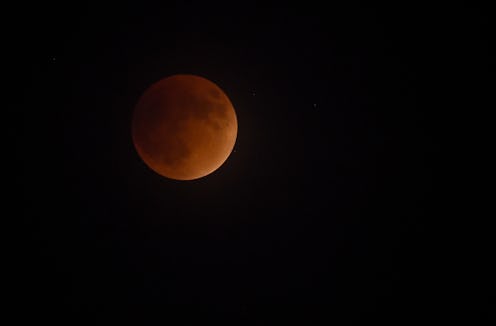Life
Here’s Why Next Week’s Full Moon Has Such A Weird Name

When the moon hits your eye like a big pizza pie on Jan. 31, you may be wondering why people are calling it the "super blue blood moon." Yes, it seems like every month, the Internet is all aflutter with some new lunar lunacy — supermoons! wolf moons! black moons! — but at the end of the month, the moon will be special for three separate reasons. On their own, blue moons, supermoons, and blood moons aren't particularly noteworthy. Taken together, they add up to a rare celestial event.
First, the full moon on Jan. 31, 2018, will be a blue moon. The name is actually a bit misleading; during a blue moon, our celestial neighbor doesn't literally turn blue for a night. It simply refers to the second full moon in a single month. Unless you were busy sleeping off a hangover, you may recall that the first full moon of the year took place on Jan. 1, making the upcoming full moon a blue moon. As you've undoubtedly guessed by now, that takes care of the "blue" part of the name up there.
At the same time, it will be a supermoon, which happens when a full moon coincides with its closest approach to Earth. Its orbit isn't circular, but elliptical, so there are certain points where it appears slightly smaller or larger to us Earthlings. (Emphasis on the slightly.) According to Space.com, a supermoon can appear up to 30 percent brighter and 14 percent larger, although that's hard to spot with the naked eye. Still, people tend to get pretty excited about supermoons, and this one will be the third in a series stretching back to December 2017.
Finally, the bit about the blood moon is probably the most exciting. A lunar eclipse visible from North America, Asia, the Pacific, and Australia will take place on Jan. 31. For the most part, the moon's orbit takes it above the Earth's path around the sun, but every once in a while, it crosses behind our planet, where we block the sun's light. You may recall from science class that the moon doesn't give off light of its own; instead, it reflects the sun's light. This means that as it moves into the Earth's shadow, it starts to darken. But once it's fully enveloped, it doesn't go black. Instead, it turns reddish.
According to Time and Date, this is thanks to a phenomenon known as Rayleigh scattering. The website explains that when sunlight strikes the Earth's atmosphere, it is scattered in all sorts of directions, but not all colors are scattered equally.
"Colors with shorter wavelengths, especially the violet and blue colors, are scattered more strongly, so they are removed from the sunlight before it hits the surface of the Moon during a lunar eclipse. Those with longer wavelengths, like red and orange, pass through the atmosphere. This red-orange light is then bent or refracted around Earth, hitting the surface of the Moon and giving it the reddish-orange glow that total lunar eclipses are famous for."
The reddish glow of a lunar eclipse has earned it the nickname "blood moon." (Fun fact: This process is also responsible for colorful sunsets and the color of the sky.)
There you have it! The full moon on Jan. 31 will simultaneously be a supermoon, blue moon, and blood moon. Some have claimed this is the first blue moon total eclipse in 150 years, but as EarthSky points out, that's only true for North America.
If you're interested in catching the big event, you'll have to keep odd hours. In North America and the Hawaiian Islands, the lunar eclipse will be visible before sunrise; in Asia, the Middle East, and the Pacific, it will take place after sunset. Happy skywatching!